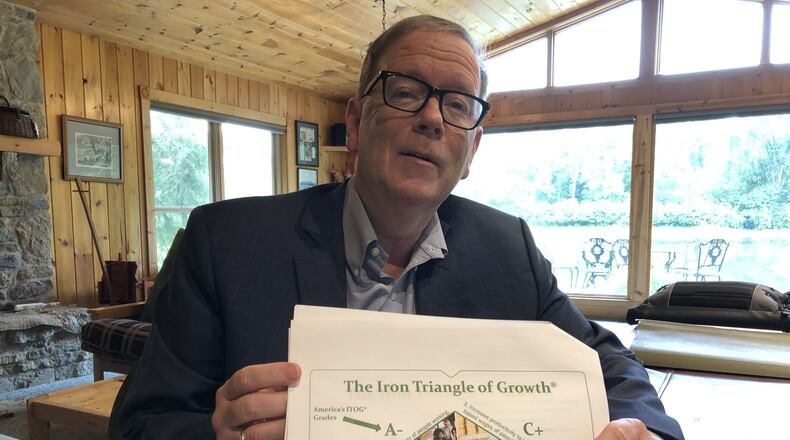MORE: Entertainment concept opening at Dayton Mall this month
Last year, the Cunningham Institute for Growth (CIG), Warren County public school officials and business leaders established a program with the United Way of Warren County, mentoring and training high-school seniors uninterested in college to develop skills enabling them to earn $25 an hour within four years.
“There was nothing for them,” Cunningham. “They want to see the way forward.”
More than 450 students from five school districts participated and 23 graduated with jobs with participating local businesses and expectations of career advancement.
“It’s a huge issue across the country,” Aaron Reid, president and CEO of the United Way of Warren County, said.
PHOTOS: Did we spot you at Beavercreek’s 4th of July celebration?
Cunningham, also a former member of the Executive Committee of the Cincinnati Branch of the Federal Reserve Bank of Cleveland, credited Reid with the success of the pilot program.
“He and I want to make this a national model,” Cunningham said. “It’s going to be bigger next year.”
Reid said the institute would also be involved in analyzing data from the program as it moved ahead.
“This had never been done before,” Reid said.
MORE: West Chester company moves manufacturing work back to U.S.
Formed in 1862 in Cincinnati, the Cunningham’s family business, Long-Stanton, does metal stamping and sheet metal fabrication for a wide range of industries, including aerospace and medical.
The company employs about 90 people.
Cunningham, sole owner since 1998, said he decided he needed to take an active role in sustaining economic growth in the country in 2005 after being introduced to an employee’s young family.
In 2005, the growth rate was 2 percent, and the U.S. economy was stalling. He worried the U.S. economy would be unable to adequately provide for American families’ futures.
“How do you fix it?” Cunningham said. “How do you communicate how to fix it?”
PHOTOS: Did we spot you celebrating the Fourth of July at the Americana Festival?
Cunningham, who grew up in the Lebanon area, was an Advanced Leadership Fellow at Harvard University in 2013 and got his master’s degree in public administration at the Harvard Kennedy School of Government in 2016.
“Dan Cunningham is a dedicated businessman, with a real belief in the American system, so I applaud his efforts. I think most of what he says makes a lot of sense,” said Willy Shih, the Robert and Jane Cizik Professor of Management Practice for the Harvard Business School.
Cunningham also has an engineering degree from Ohio Northern University and studied at Xavier University and the Massachusetts Institute of Technology.
After his Harvard years, Cunningham returned home to Warren County and set up the Cunningham Institute and honed the Iron Triangle tool.
“I want it to be accurate and simple,” he said.
MORE: Lebanon plans development of 500 acres
Cunningham, a Republican, hopes to join President Donald Trump’s National Economic Council to take his ideas to the federal level. He speaks around the country and is looking for collaborators to help spread the word about how to sustain economic growth.
“The most important thing is to get it going at the grassroots,” he said last week at his home outside Lebanon.
MORE: Neighbors see construction start on massive Warren County development
Cunningham, 65, explained that the U.S. economy is based largely on a balance of consumer spending, business investment and government spending, known as gross domestic product (GDP).
He used a Wall Street Journal video to explain the relationship between GDP and growth.
Last year the U.S. GDP was $21 trillion with 3 percent growth for the second consecutive year. China’s GDP was $14 trillion with a 6 percent growth rate.
Cunningham’s three-sided model is to be used to analyze the needs of an area, state or community unable to sustain a 3 percent growth rate.
In some cases, the problem is a shortage of people working. In other cases, growth problems can be traced to a lack of “productivity,” keeping wages too low for workers to adequately support themselves and their families.
The third leg emphasizes the need for workers who lose their jobs due to changes in the economy to pivot quickly through education, training or other support.
To Harvard’s Shih, this is the toughest part.
“This really requires investments in lifelong learning, and people have to be committed to keeping their skills up to date, which is practical, but requires the proper mindset. You have to instill this attitude early,” Shih said in an email response.
To Cunningham, the Iron Triangle offers different solutions for a range of problems.
“If you can’t find your solution on one leg, look at the other two, you’ll find it,” Cunningham said.
For example, in western Butler County, Cunningham said, “they need more people,” boosting the population to draw supermarkets and employers.
“You have incentives to live there,” he suggested.
While growing in population, Warren County employers struggling to find qualified workers could focus on attracting “skilled legal immigrants,” according to Cunningham.
“We’re not looking at economic growth locally,” he said, “what you and I can do to get the growth rate up.”
THE IRON TRIANGLE OF GROWTH
To Increase Number of People Working:
Increase number of legal skilled immigrants.
Increase labor participation rate.
Increase market-based wages.
Replace negative incentives for Americans on welfare with positive incentives to leave welfare.
Reduce income taxes by taxing the income for every worker the same tax rate.
Adequate nutrition.
Increase number of people, i.e. more babies.
Reduce infant mortality rate.
Give awards to families that have babies.
Child care options.
Adequate health care.
To Increase Productivity, Increase Market-based Wages of People Working:
Improve ability to decrease the amount of time or resources to complete a work task.
Improve tools, or physical capital per worker.
Improve human capital, or level of knowledge, and skills per worker.
Reduce racial and gender wealth inequality.
Reduce cost and increased availability of natural resources.
Improve technical knowledge, i.e. patents.
Increase business investment.
Increase private and government R&D.
To Quickly Pivot Americans Out of Work to Higher Market-Based Wage Jobs:
As much as possible, let the market sort out the best way.
Regulate as little as possible; only when absolutely necessary for safety and health.
You, your family, and your community can start these and other actions.
Only allow the government to participate as a last resort.
Stop writing off or excluding anyone anyone as potential contributing member of community.
Tutor child or adult in occupations that are viable for today and tomorrow’s economy.
Consider supporting someone who is pivoting through childcare, transportation, education, talk with them.
Source: Cunningham Institute for Growth
About the Author

